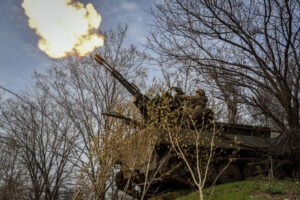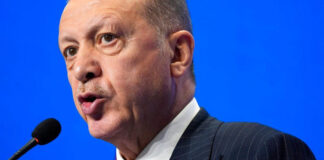APRIL 10, 2023

The leak of a trove of classified U.S. military documents, some of which began to spread on chat platforms in recent weeks and more of which have emerged since, has spooked officials around the world — none more so than in Washington, as the defense and intelligence establishment scrambles to assess the damage and the Justice Department looks for answers.
The documents offer an unvarnished look at high-level U.S. assessments of the war in Ukraine, including tactical information about Ukrainian forces ahead of an expected spring offensive. But the impact may be broader-reaching, with some documents detailing apparent U.S. intelligence-gathering targeting allies, including South Korea and Israel.
Much about the leak remains unclear. Some documents were shared on Discord, before appearing on Telegram and Twitter, yet their original source is not certain. Some of the initial documents that spread widely appear to have been doctored to show a more positive outlook for Russia in Ukraine. Many others appear to be unaltered.
It is not known how many documents were leaked in total, let alone who leaked them or why. While the scale of the breach appears smaller than some other recent leaks of classified U.S. material, the sensitive subject matter and relative recency are major worries for U.S. officials.
What are the leaked documents?
The leak contains at least several dozen images of paper documents. The documents appear to have been printed and folded before being photographed. Some objects in the background of the photos, such as a hunting scope, suggest they were photographed in the same location.
Many of the documents appear to be briefings prepared for senior Pentagon leadership, including Gen. Mark A. Milley, chairman of the Joint Chiefs of Staff. They include assessments from the National Security Agency, the CIA, the Defense Intelligence Agency, law enforcement agencies and the National Reconnaissance Office.
Most have classified markings. Some are labeled “NOFORN,” meaning they cannot be released to foreign nationals. Others state they are meant to be shared with close U.S. allies, including the Five Eyes alliance of the United States, Britain, Canada, Australia and New Zealand. Some are marked “top secret,” a designation at the highest level of U.S. security classifications.
Most of the information in the documents was gathered over the winter and published in late February and early March, so it does not necessarily represent a current view. The documents are largely focused on the fighting in Ukraine, but they detail other fraught geopolitical situations, including assessments of China and Iran.
What information do the documents reveal?
Given the large number of documents that have leaked, the full extent of their revelations has probably not been revealed. But already, a number of details stand out.
- The documents give a blunt assessment of Ukraine’s military strength after a year of heavy fighting, pointing to weak spots in Ukrainian air defenses and likely problems with ammunition supplies.
- One document describes how a Russian fighter jet nearly shot down a British surveillance plane on Sept. 29 off the coast of Crimea — an incident that could have been far more dangerous than was publicly acknowledged at the time.
- The leak suggests the U.S. intelligence community has infiltrated the Russian military and is able to warn Ukraine of upcoming attacks. There are also discussions of internal planning by the GRU, Russia’s military intelligence agency, and the Wagner Group, the private military contractor crucial to Russia’s war effort.
- Documents appear to contain details about new surveillance technology in use by the United States to aid Ukraine, including an advanced satellite imagery system known as “LAPIS time-series video.” Some U.S. officials fear that Russia could use the information to disrupt this technology.
- One report suggests that Turkey, a NATO ally, was approached by Wagner to help procure supplies. That document states that Wagner’s representatives “met with Turkish contacts to purchase weapons and equipment from Turkey for Vagner’s efforts in Mali and Ukraine,” using a variation on the spelling of the group’s name. It is unclear how much Turkey may have known about the efforts and whether they were concluded.
- Another document reports that South Korea’s National Security Council in early March “grappled” with a U.S. request that the country send artillery ammunition to Ukraine. Seoul was concerned that the request could anger Moscow, the report said, citing signals intelligence.
- Israel is also named in the documents. One report says that in February, senior leaders of the Mossad spy service “advocated for Mossad officials and Israeli citizens to protest the new Israeli Government’s proposed judicial reforms, including several explicit calls to action that decried the Israeli Government, according to signals intelligence.”
How did the leak happen?
The leak first gained widespread attention in early April, after the New York Times reported that the Pentagon was investigating the matter.
Journalists and other investigators were soon tracing back along the timeline of posts shared online. They found images of leaked documents on social networks such as Twitter and Telegram, and earlier still on 4chan, a notoriously misanthropic online message board. The trail eventually led to initial threads on Discord, where images of leaked documents were shared by a user to a server called “Wow Mao” on Feb. 28 and March 2.
Discord is a chat community popular with gamers and streamers. Wow Mao is the name of a popular YouTuber, and some of the early discussion of the leak took place on a chat devoted to the world-building game Minecraft. Whoever first shared the images is not necessarily their source.
The Justice Department has opened an investigation into the leak and Discord has said it is cooperating with authorities. In the past, Americans who were convicted of mishandling classified information have faced long prison terms. However, finding the source of a leak is not easy: It is believed that hundreds, if not thousands, of people may have had access to the documents before they leaked.
Russia has used third parties to leak sensitive information acquired from the United States through hacking in the past, U.S. investigations found. Some versions of the leaked documents that spread on Twitter last week appeared to have been crudely manipulated to make things look better for Moscow’s war efforts by reducing confidential U.S. estimates of Russian war dead.
What has the reaction been?
The leak has caused a significant reaction in Washington. In addition to the Justice Department investigation, U.S. officials have said that Pentagon leadership is restricting the flow of intelligence in response to the revelations.
“An interagency effort has been stood up, focused on assessing the impact these photographed documents could have on U.S. national security and on our Allies and partners,” Pentagon deputy spokeswoman Sabrina Singh said in a statement Sunday.
In Ukraine, some officials have responded with frustration, as the leak appeared to include important information ahead of an expected spring offensive and could hinder information sharing between Kyiv and Washington. Some Ukrainian officials have also questioned the accuracy of the contents. Presidential adviser Mykhailo Podolyak wrote on Telegram that the leaked documents contained largely “fictitious information” and had “nothing to do with Ukraine’s real plans.”
Russia has begun analyzing the documents, Kremlin spokesman Dmitry Peskov said Monday, adding that they appeared to be “quite interesting.” Some pro-Russian military bloggers have warned against reading too much into the leak, arguing without evidence that it could be a U.S. disinformation campaign.
The leak is already causing complications for Washington’s relationship with some allies. The Israeli government over the weekend released a statement on behalf of the Mossad spy agency describing the report that mentions it as “mendacious and without any foundation whatsoever,” while South Korea’s presidential office said it would seek “appropriate measures” from the United States if the leaks were verified.
Courtesy/Source: Washington Post

































































































